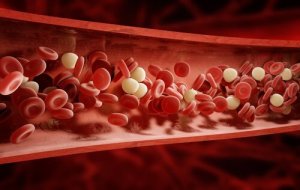Post-Partum Hemorrhage: What You Need to Know

Post-partum hemorrhage occurs after giving birth, whether vaginal or via cesarean section.
After vaginal birth, the loss of blood can reach 500 milliliters, and up to 1000 milliliters after cesarean section. This loss of blood is dramatic can put the mother’s life at risk.
It’s a delicate condition given that it can occur even up to 6 months after giving birth. In other words, it can occur during the post-partum period. In these cases, the doctor will evaluate the use of saline solutions and blood transfusions.
This is why it’s so important for the mother to receive medical care from the very start.
Risk factors for post-partum hemorrhage
Certain risk factors can lead to post-partum hemorrhage – for example, illnesses or injuries prior to birth or special conditions such as a multiple pregnancy, among others.
You’ll find a more detailed list below:
- Diabetes.
- Anemia.
- Lupus erythematosus.
- Uterine curettage.
- High blood pressure.
- Uterine fibroids.
- Multiple pregnancy.
- Previous uterine scars.
- Being older than 35.
- Abdominal trauma.
- Uterine atony or hypotonia.
- Background of preeclampsia
- Use of drugs, alcoholism, or tobacco use.
- Hemorrhages in previous pregnancies.
Incidence
Post-partum hemorrhages occur in 10% of births. According to the World Health Organization, it’s one of the most common causes of death both in developed and developing countries.
As for the causes, 75% of cases are due to uterine atony or hypotonia.

Causes and treatment
1. Uterine atony
This occurs when there is a loss of muscle tone in the uterine musculature. The uterus cannot contract and this slows down its recovery after birth, which causes the hemorrhage.
There are two possible treatments for this condition:
- The first and most common treatment is a massage (always done by an expert) to stimulate the uterus and make it contract.
- The second possible treatment consists of the administration of uterotonic medications such as: oxytocin, ergotamine, methergin, carboporost, and misoprostol.
2. Uterine tearing
Uterine tearing can be due to trauma, lacerations, or hematomas. The incidence of post-partum hemorrhages from this cause make up 19% of births, both natural and cesarean.
Depending on the case, your doctor will decide what the best way to treat these lesions may be. Before applying any, he or she will order an ultrasound.
3. Retention of parts of the placenta
Another cause of post-partum hemorrhage is retention of parts of the placenta. Fortunately, this only occurs in 10% of births and can be quickly treated.
When there are residual parts of the placenta in the uterus, they must be extracted to stop the bleeding.
To perform this procedure, the doctor must clean out all the residue manually with gauze. Of course, this requires painkillers for the patient, as she might feel some discomfort.
4. Thrombins
Among the causes of post-partum hemorrhage, thrombins are worth highlighting. These are congenital or inherited coagulopathies of thrombocytopenias. These occur in women with extreme anemia. These cases are only 1% of deliveries.
Every case connected to thrombins is studied beforehand via clinical exams and patient histories, and the post-partum treatment mainly consists of blood transfusions, platelet transfusions, and fresh frozen plasma.
Medical monitoring is rigorous and continues until the patient is completely recovered.

Final considerations
Post-partum hemorrhage can occur for various reasons. Now, regardless of origin, medical treatment and monitoring are indispensable.
Keep in mind that, as a treatment is put into practice, it’s important to be careful with diet and hydration to help the mother recover.
Post-partum hemorrhage is determined when there is a loss of blood between 450 and 1200 milliliters. The most common symptoms are dizziness, syncope, tachycardia, and fatigue.
Go immediately to the closest medical facility and seek professional medical assistance. Under no circumstances should you delay treatment.
Post-partum hemorrhage occurs after giving birth, whether vaginal or via cesarean section.
After vaginal birth, the loss of blood can reach 500 milliliters, and up to 1000 milliliters after cesarean section. This loss of blood is dramatic can put the mother’s life at risk.
It’s a delicate condition given that it can occur even up to 6 months after giving birth. In other words, it can occur during the post-partum period. In these cases, the doctor will evaluate the use of saline solutions and blood transfusions.
This is why it’s so important for the mother to receive medical care from the very start.
Risk factors for post-partum hemorrhage
Certain risk factors can lead to post-partum hemorrhage – for example, illnesses or injuries prior to birth or special conditions such as a multiple pregnancy, among others.
You’ll find a more detailed list below:
- Diabetes.
- Anemia.
- Lupus erythematosus.
- Uterine curettage.
- High blood pressure.
- Uterine fibroids.
- Multiple pregnancy.
- Previous uterine scars.
- Being older than 35.
- Abdominal trauma.
- Uterine atony or hypotonia.
- Background of preeclampsia
- Use of drugs, alcoholism, or tobacco use.
- Hemorrhages in previous pregnancies.
Incidence
Post-partum hemorrhages occur in 10% of births. According to the World Health Organization, it’s one of the most common causes of death both in developed and developing countries.
As for the causes, 75% of cases are due to uterine atony or hypotonia.

Causes and treatment
1. Uterine atony
This occurs when there is a loss of muscle tone in the uterine musculature. The uterus cannot contract and this slows down its recovery after birth, which causes the hemorrhage.
There are two possible treatments for this condition:
- The first and most common treatment is a massage (always done by an expert) to stimulate the uterus and make it contract.
- The second possible treatment consists of the administration of uterotonic medications such as: oxytocin, ergotamine, methergin, carboporost, and misoprostol.
2. Uterine tearing
Uterine tearing can be due to trauma, lacerations, or hematomas. The incidence of post-partum hemorrhages from this cause make up 19% of births, both natural and cesarean.
Depending on the case, your doctor will decide what the best way to treat these lesions may be. Before applying any, he or she will order an ultrasound.
3. Retention of parts of the placenta
Another cause of post-partum hemorrhage is retention of parts of the placenta. Fortunately, this only occurs in 10% of births and can be quickly treated.
When there are residual parts of the placenta in the uterus, they must be extracted to stop the bleeding.
To perform this procedure, the doctor must clean out all the residue manually with gauze. Of course, this requires painkillers for the patient, as she might feel some discomfort.
4. Thrombins
Among the causes of post-partum hemorrhage, thrombins are worth highlighting. These are congenital or inherited coagulopathies of thrombocytopenias. These occur in women with extreme anemia. These cases are only 1% of deliveries.
Every case connected to thrombins is studied beforehand via clinical exams and patient histories, and the post-partum treatment mainly consists of blood transfusions, platelet transfusions, and fresh frozen plasma.
Medical monitoring is rigorous and continues until the patient is completely recovered.

Final considerations
Post-partum hemorrhage can occur for various reasons. Now, regardless of origin, medical treatment and monitoring are indispensable.
Keep in mind that, as a treatment is put into practice, it’s important to be careful with diet and hydration to help the mother recover.
Post-partum hemorrhage is determined when there is a loss of blood between 450 and 1200 milliliters. The most common symptoms are dizziness, syncope, tachycardia, and fatigue.
Go immediately to the closest medical facility and seek professional medical assistance. Under no circumstances should you delay treatment.
All cited sources were thoroughly reviewed by our team to ensure their quality, reliability, currency, and validity. The bibliography of this article was considered reliable and of academic or scientific accuracy.
- Edhi, M. M., Aslam, H. M., Naqvi, Z., & Hashmi, H. (2013). Post partum hemorrhage: Causes and management. BMC Research Notes. https://doi.org/10.1186/1756-0500-6-236
- Clark, S. L. (2016). Obstetric hemorrhage. Seminars in Perinatology. https://doi.org/10.1053/j.semperi.2015.11.016
This text is provided for informational purposes only and does not replace consultation with a professional. If in doubt, consult your specialist.








